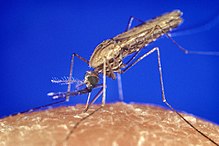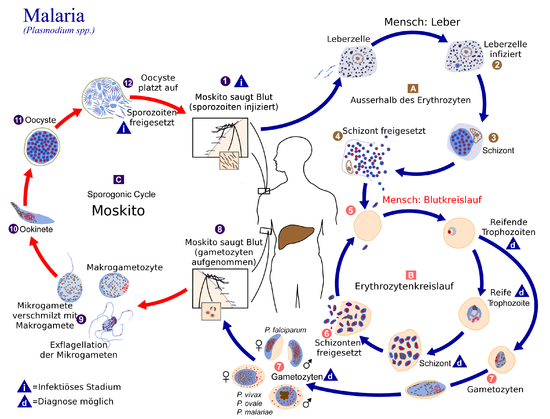Malaria
![]()
This article explains the disease; for the German band, see Malaria!
Malaria - also called swamp fever, paludism, intermittent fever, marsh fever, febris intermittens, cold fever or obsoletely acclimatisation fever, climatic fever, coastal fever, tropical fever - is an infectious disease caused by unicellular parasites of the genus Plasmodium. Nowadays it is transmitted mainly in the tropics and subtropics by the bite of a female mosquito of the genus Anopheles. Outside these areas, mosquitoes introduced by air occasionally cause the so-called "airport malaria". In this case, all persons in the direct vicinity of airports are at risk, e.g. airport employees or residents. Except for transmission by blood transfusion and laboratory accidents, human-to-human infection is only occasionally possible from mother to unborn child if the placenta is injured (especially during birth). Humans and Anopheles mosquitoes represent the only significant pathogen reservoir of human pathogenic plasmodia.
Malaria is the most common infectious disease in the world, with around 200 million people contracting the disease each year. Using scientific computer models, about 1.2 million deaths due to malaria infection were calculated for the year 2010 after data were collected from 1980 to 2010. According to the models, the number of malaria deaths peaked in 2004 at 1.8 million.
Previously, only four pathogens were considered to be pathogenic for humans: Plasmodium falciparum, Plasmodium vivax, Plasmodium ovale and Plasmodium malariae. It is now known that another strain from Southeast Asia, previously thought to be mainly dangerous to macaques, can also infect humans in larger numbers than previously thought: Plasmodium knowlesi. In terms of their disease course and geographical distribution, the pathogens differ considerably. Plasmodium falciparum is the most clinically significant and threatening pathogen of malaria, which was formerly also referred to as malignant alternating fever.
Basically, according to the different malaria parasites, three disease patterns are distinguished: Malaria tropica, Malaria tertiana and Malaria quartana. The symptoms of malaria are high, recurrent to periodic (alternating) fever, chills, complaints of the gastrointestinal tract and convulsions. Especially in children, the disease can rapidly lead to coma and death. The frequency of fever episodes results from the length of the multiplication cycles of the pathogens.
In Austria and Switzerland the disease is notifiable, in Germany only the detection of the pathogen (except in Saxony).
Word Origin
The disease name malaria is derived from Italian mal'aria ("bad air", which rises as a bad exhalation, also called miasma, especially from the swamps, and was held since antiquity to cause disease, especially in the case of alternating fever (febris intermittens)), from Latin mala "bad", and aer "air". The Italian term mal(a) aria is found in 1709 in a work extensively treating this disease by the physician Francesco Torti (1658-1741), a personal physician to Francesco II d'Este and Rinaldo d'Este.

The mosquito Anopheles at the blood meal
Pathogen
List of human pathogens
| ||||||||||||||||||||||||
| (* in case of insufficient malaria prophylaxis) |
The pathogen belongs to the Apikomplexa. The pathogens Plasmodium falciparum, Plasmodium vivax, Plasmodium ovale, Plasmodium malariae and Plasmodium knowlesi, which can trigger various forms of malaria, are dangerous for humans.
In addition, Plasmodium can also cause semioval malaria. In multiple infections with the same or different plasmodia, the fever attacks can also be irregular. The otherwise regular typical alternating fever is absent, there is irregular and possibly permanent fever. Since the schizogonic cycle of P. knowlesi is 24 h, this infection manifests itself in malaria quotidiana with daily febrile attacks.
Life cycle
In the course of their life cycle, the pathogens of malaria, the plasmodia, change hosts. Humans serve as intermediate hosts. Mosquitoes, especially of the genus Anopheles, serve as the final host. The plasmodia reproduce in them.
In humans (asexual phase/schizogony)
After a person has been bitten by an infected Anopheles mosquito, it secretes several hundred sporozoites with its saliva, which contains anticoagulants. These are carried with the bloodstream to the liver, where they penetrate the spleen and, above all, the cells of the liver tissue, where they mature into the liver schizont. There they multiply (divide), called exoerythrocytic schizogony. This gives rise to up to 30,000 merozoites. The schizont dissolves and releases the merozoites gradually into the bloodstream enclosed in vesicles. In Plasmodium vivax and Plasmodium ovale, not all the merozoites go this route; a small proportion may survive undivided in the liver cell as hypnozoites. In this dormant state, they can remain undetected by the immune system for months to years. Due to an unknown stimulus, the hypnozoites mature into schizonts, which leads to characteristic relapses of malaria tertiana.
The merozoites enter the bloodstream and attach to receptor molecules of red blood cells, whereupon they can penetrate them and are enclosed within a membrane-limited, parasitophoric vacuole. With the infestation of red blood cells, erythrocytic schizogony begins. The merozoites then mature into a trophozoite. At this stage, the pathogen appears as a ring around its own food vacuole with a dark-colored, marginal nucleus. The trophozoite matures further into a schizonts that feeds primarily on glucose and hemoglobin. This produces heme, which, however, is immediately crystallized to hemozoin, since free heme is toxic to the trophozoite. After multiple division, 6 to 36 merozoites emerge from the schizonts, depending on the Plasmodium species. Due to their large quantity, these cause the erythrocyte to burst and are thus distributed in the blood plasma. There the merozoites can infect further erythrocytes and the asexual cycle begins again. After a short initial phase, the schizogony cycles proceed synchronously at regular intervals of 48 (Plasmodium vivax, ovale, falciparum, but the latter is unsynchronized) and 72 hours (Plasmodium malariae). The fever following the destruction of the erythrocyte accordingly occurs every 3 or 4 days (malaria tertiana and malaria quartana) due to the synchronization of this cycle. A small number of the merozoites go on to develop into their sexual forms, the gametocytes. These are then found in the blood, where they die again after some time (Plasmodium vivax: 1 day, Plasmodium falciparum: up to 22 days), unless they are ingested by an Anopheles mosquito. The male gametocytes are called microgametocytes, the female macrogametocytes.
In the mosquito (sexual phase/sporogony)
When a mosquito bites again, the gametocytes are absorbed into the mosquito. They develop into gametes in her intestine. The microgametes penetrate the macrogametes and a zygote develops. This changes, takes on an elongated shape and becomes motile (= mobile). this cell is now called an ookinet. It attaches itself between the tissue layers of the mosquito's intestine, where it transforms into an oocyst. Up to 1,000 new sporozoites develop in it. After their release, they migrate into the mosquito's salivary glands and are now ready for reinfection. The cycle in the Anopheles lasts between 8 and 16 days, depending on the outside temperature. A minimum temperature of 15 °C is required. Below this temperature, the cycle no longer occurs.
Human-to-human infection routes
Without the mosquito route, malaria can be transmitted from person to person via blood.
There are two known ways to do this:
- About the injured placenta of a pregnant woman during childbirth on her child.
- In the course of a blood transfusion.
Following the death of an 84-year-old woman on March 18, 2019, after surgery involving blood transfusions the previous February in Carinthia, it has been reported that malaria caused her death, according to prosecutors. Blood bags are traceable to donors. Those wishing to donate must declare foreign travel and are not allowed to donate within 6 months of returning from a malaria-affected area. Donated blood is not yet tested for malaria pathogens in Austria.

Life cycle of plasmodia
Questions and Answers
Q: What is malaria?
A: Malaria is an infectious disease caused by a parasite that is spread by the bite of an infected mosquito. It can be deadly and kills many people each year.
Q: What causes malaria?
A: Malaria is produced by 4 species of the protozoal parasite Plasmodium, which are endemic in many tropical countries.
Q: How many cases of malaria occur globally each year?
A: According to WHO estimates (2011), between 149 and 274 million clinical cases and ~ 0.655 million deaths occur globally due to malaria each year, 90% of which are in Africa. This amounts to one malaria death every minute.
Q: How did India achieve near complete disappearance of the disease in 1960s?
A: In India, the National Malaria Eradication Programme (NMEP), started in 1958, achieved near complete disappearance of the disease in 1960s (from 75 million cases in 1950s to 0.1 million cases in 1960s).
Q: What type of organism is responsible for causing malaria?
A: The parasite that causes malaria is a protozoan called 'Plasmodium'. Protozoa are organisms with only one cell, but they are not bacteria; bacteria are smaller and simpler than protozoans.
Q: How do mosquitoes transmit Plasmodium into humans?
A: People usually get malaria from Anopheles or Culex mosquitoes; these mosquitoes act as vectors for the disease by injecting their saliva containing Plasmodium into humans when they bite them.
Q: Are there other ways people can catch malaria besides being bitten by a mosquito?
A: Yes, babies can get it while inside their mother (maternal-foetal transmission), people can also get it from a blood transfusion or using a needle that someone with the disease used before them.
Search within the encyclopedia